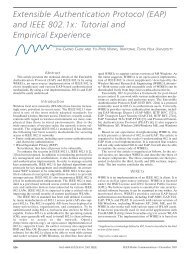Design and Implementation of WIRE1x - Wireless Internet Research ...
Design and Implementation of WIRE1x - Wireless Internet Research ...
Design and Implementation of WIRE1x - Wireless Internet Research ...
Create successful ePaper yourself
Turn your PDF publications into a flip-book with our unique Google optimized e-Paper software.
Currently both CCC <strong>and</strong> the Computer Science(CS) department at NTHU have deployed WLANsby using 802.1x <strong>and</strong> RADIUS to authenticate users.To achieve roaming, both <strong>of</strong> their RADIUS serverscould connected together as shown in Fig 7. Assuminga user abc has an account at CCC. Once the userroams to the WLANs covered by the CS department,the CS RADIUS server can authenticate the user byrelaying the authentication messages back to the CCCRADIUS. The CS RADIUS server acts as a proxyclient to the CCC RADIUS server. With only oneaccount at CCC, the user still could roam to otherWLANs.At NTHU, most users are using MS Windows.Since <strong>WIRE1x</strong> was released on June 18, 2003, thewebsite <strong>of</strong> <strong>WIRE1x</strong> has been visited around 3000times. There have been more than 320 downloads <strong>of</strong>source code <strong>and</strong> 350 downloads <strong>of</strong> executable code <strong>of</strong><strong>WIRE1x</strong>.6. SUMMARY AND FUTURE WORKThis paper presents the motivation <strong>of</strong> <strong>WIRE1x</strong>.The implementation are discussed in details. By readingthis paper, one should be able to examine thesource code <strong>of</strong> <strong>WIRE1x</strong> in addition to use it. Currently,<strong>WIRE1x</strong> supports only some specific wireless cards<strong>and</strong> provides only EAP MD5-Challenge. However, wewill continue to improve it. We hope <strong>WIRE1x</strong> will notonly be used at NTHU, but will also play a crucialrole for the integration <strong>of</strong> WLANs among differentuniversities, companies, <strong>and</strong> organizations.ACKNOWLEDGMENTSWe thank other members <strong>of</strong> the WIRE Lab, especiallyChin-Hsing Lin, Wen-Ting Wu, <strong>and</strong> Jui-HungYeh, for helping the development <strong>of</strong> <strong>WIRE1x</strong>. We alsothank the support <strong>of</strong> the Computer <strong>and</strong> CommunicationCenter, National Tsing Hua University, <strong>and</strong> theComputer Center, Department <strong>of</strong> Computer Science,National Tsing Hua University.This work was sponsored in part by MOE Programfor Promoting Academic Excellent <strong>of</strong> Universitiesunder the grant number 89-E-FA04-1-4, NationalScience Council under the grant numbers 91-2219-E-007-023 <strong>and</strong> 92-2213-E-007-019, <strong>and</strong> Industrial Technology<strong>Research</strong> Institute under the contracts <strong>of</strong> T1-92019-3 <strong>and</strong> 2F-92050-4.REFERENCES[1] ABOBA, B., AND SIMON, D. PPP EAP TLSauthentication protocol. IETF RFC 2716, Oct.1999.[2] ANDERSSON, H., JOSEFSSON, S., ZORN, G.,SIMON, D., AND PALEKAR, A. Protected EAPprotocol (PEAP). draft-josefsson-pppext-eap-tlseap-02.txt,Feb. 2002.[3] BLUNK, L., AND VOLLBRECHT, J. PPP extensibleauthentication protocol (EAP). IETF RFC2284, Mar. 1998.[4] CALHOUN, P. R., ARKKO, J., GUTTMAN, E.,ZORN, G., AND LOUGHNEY, J. Diameter baseprotocol. draft-ietf-aaa-diameter-12.txt, Aug.2002.[5] CHEN, J.-C., JIANG, M.-C., AND LIU, Y.-W.<strong>Wireless</strong> LAN security <strong>and</strong> IEEE 802.11i. IEEE<strong>Wireless</strong> Communications (2004). To appear.[6] freeRADIUS. http://www.freeradius.org/.[7] FUNK, P., AND BLAKE-WILSON, S. EAP tunneledTLS authentication protocol (EAP-TTLS).draft-ietf-pppext-eap-tls-02.txt, Feb. 2002.[8] IEEE STD 802.11I/D2.0. Draft supplement tost<strong>and</strong>ard for telecommunications <strong>and</strong> informationexchange between systems - part 11: wirelessMAC <strong>and</strong> PHY specifications: specification forenhanced security, Mar. 2002.[9] IEEE STD 802.1X-2001. IEEE st<strong>and</strong>ard forlocal <strong>and</strong> metropolitan area networks, port-basednetwork access control, Oct. 2001.[10] The InteropNet Labs (iLabs).http://www.ilabs.interop.net/WLAN Sec 2002Spring/ni 2002 las about us.pdf.[11] JIANG, M.-C., LIU, Y.-W., AND CHEN, J.-C.Integration <strong>of</strong> Mobile IP with WLAN Security. InProc. <strong>of</strong> 2002 Taiwan Area Network Conference(Hsinchu, Taiwan, Oct. 2002), pp. 950–955.[12] Libnet. http://libnet.sourceforge.net/.[13] Lightweight extensible authentication protocol -LEAP. http://www.cisco.com/.[14] Open1x. http://www.open1x.org/.[15] RIGNEY, C., WILLENS, S., RUBENS, A., ANDSIMPSON, W. Remote authentication dial in userservice (RADIUS). IETF RFC 2865, June 2000.[16] RIVEST, R. The MD5 message-digest algorithm.IETF RFC 1321, Apr. 1992.[17] WinPcap. http://winpcap.polito.it/.



